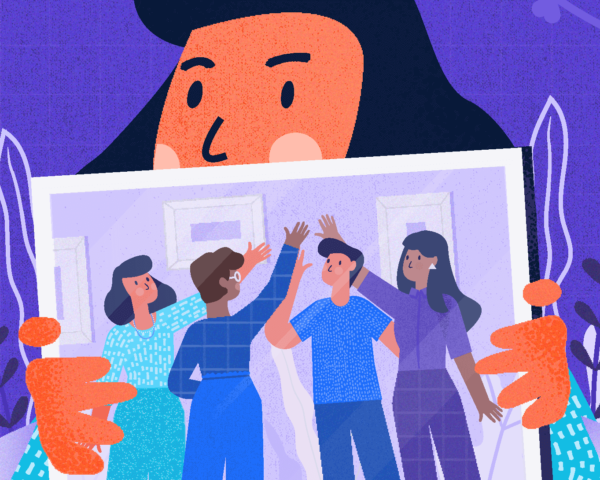Oh, snap! Did we just create the world’s first collaborative sonic brand?
We couldn’t have done it alone. Learn about our process and give the final product a listen below!
You’d probably know a handful of companies – like Intel, McDonald’s, and Netflix – from their sound alone. A seconds-long musical sequence can instantly conjure a listener’s sentiments about a particular product or organization. That’s successful sonic branding at work!
But who cares what a brand sounds like, anyway? And why does it matter? For one, Atlassian does. And it matters because, like good teamwork, brands that express their uniqueness – authentically – can connect more deeply with people. Sonic branding, the expression of your brand through sound, helps a brand stand out, engage the senses, and powerfully communicate what it stands for.
The key to executing on that experience? It should feel like “you,” evoking the sentiments you want people to feel when they experience whatever you have to offer – because at the end of the day, we’re all human. Well, most of us (looking at you, Chatbots).
The Atlassian Brand team – I’m the strategy lead for that group – recently embarked on a journey to define our brand sound, with the help of experts Made Music Studio. We were guided by a few principles:
- elevate the brand and user experience
- stand out in an increasingly noisy field
- bring to life the collaborative team spirit our brand stands for
Read on to learn how we developed our sonic brand, the unique benefits of a sonic identity, and what any team can take away from our endeavor.
Why is a sonic brand important?
You can think of a sonic brand as a kind of “audio North Star” – signature sounds associated with a specific brand or product. The audible nature of this particular lever is significant for a few reasons.
Sound is intrinsically, subtly, almost magically linked to emotions. “Emotion is one of the most complicated things that the brain has to carry out, and one of the most important drivers of emotion is sound,” said Seth Horowitz, an auditory neuroscientist at Brown University, in an interview with NPR. “Everything you hear has some kind of an impact on you and changes how you respond to the rest of the world.”
In particular, sound is strongly associated with memory and its corresponding emotions, in large part because sensory processing and memory storage happen in the same part of our brain. So when people associate a sound with a brand, their sentiment for that brand is triggered each time they hear it. And oftentimes, that sentiment can turn positive because of sound.
We’re a B2B SaaS company, one of dozens, all wanting their customers and collaborators to think of them well and often. When we set out to create our sonic brand, our focus was on what sets us apart, because what sets us apart is also what people find unique and valuable about us: collaboration software and practices that help teams of all kinds tackle challenges together.
Finding the sound of collaboration
From start to finish, the process took four months, executed in four phases according to The Atlassian Way – a framework we use internally to work through the stages of building and shipping products and services.
- Wonder: In the first phase, we seek to understand our customer and potential problem to solve or opportunity to take advantage of. For us, this meant auditing our existing use of music and sound; interviews with stakeholders; and engaging our agency, Made Music Studio, culminating in a creative brief setting the direction and deliverables for the project.
- Explore: The second phase of The Atlassian Way revolves around experimenting and ideating with different solutions and definitions of success. We conducted multiple rounds of demo reviews, engaged with Atlassian employees, customers, and community members asking for their participation (more on that later), and tested sonic options with over 600 people. Based on their feedback, we refined and finalized our sonic brand.
- Make: In the Make phase, we dove into weaving our sonic brand into high visibility touchpoints, like at the end of brand advertising, as the backing track for big event moments, and tucking it in at the end of our podcasts. Over the coming months, our sonic brand will make its way into much more of our marketing landscape…and we’ll explore if/how using sound can improve the user experience in our products (back to the Wonder phase – it’s a virtuous loop!).
- Impact: In this fourth phase, we’ll use brand lift studies, along with other brand metrics, to measure the impact of our sonic brand over time.
Want to hear the finished product?

We believe we’ve created the world’s first collaborative sonic brand. Those snaps, claps, and stomps you hear were sourced from dozens of Atlassians, our customers, and members of our community, blended with organic instruments like cello, bass, and guitar, layered with digital synths and drum patterns. Like Atlassian itself, our sonic brand is a blend of human and digital. An aural rallying cry for world-changing teamwork.
Lessons learned
Leading this project, I learned that creating a sonic brand is a lot like good teamwork: it’s not about just one thing. It’s a blend of art and science, strategy and creativity, data and human judgment, conviction and an open mind. Ultimately, the best way to be effective is to look for opportunities to connect as people. Then communicate and collaborate in a way that feels authentic and unique.
At the end of the day, effective teamwork can be hard; our company exists because people need help doing it. Teams are made up of people, so good teamwork requires navigating the many deadlines, opinions, changes, processes, and, you know, work.
I’m proud that we put people at the center of our sonic brand collaboration. And look forward to giving our customers a little sonic high five as they accomplish what would otherwise be impossible alone.












































